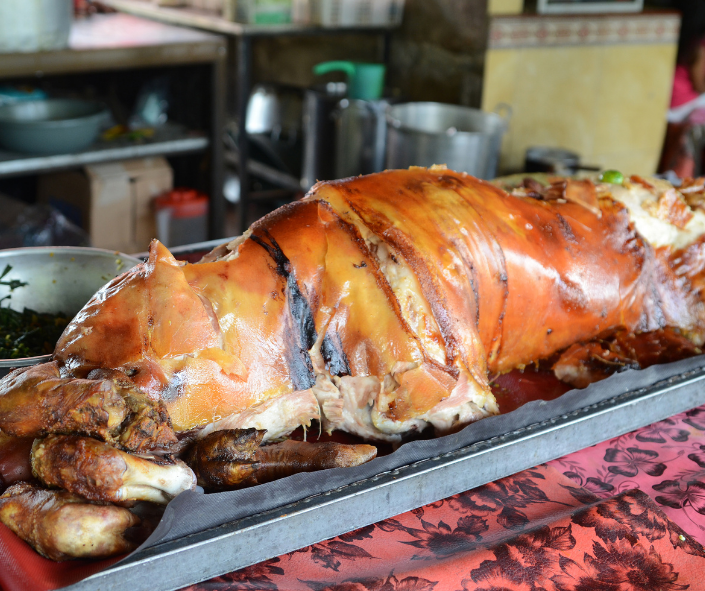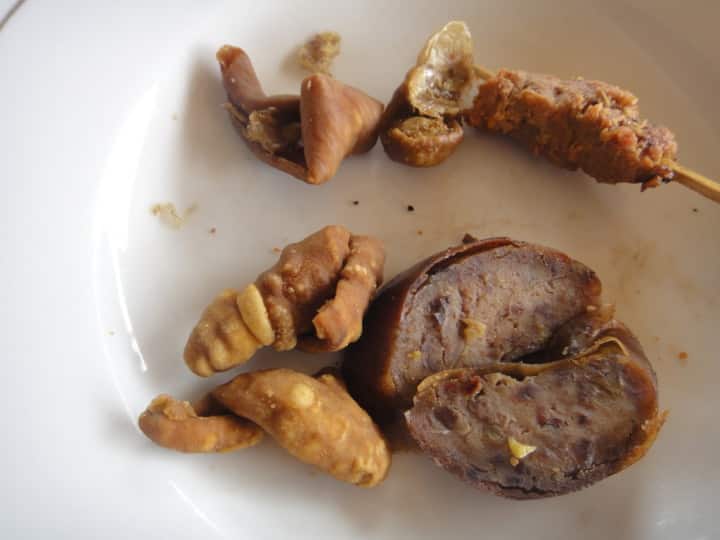The Origins and History of Babi Guling
Babu Guling: It’s a renowned dish in Balinese cuisine and derives its origins from the island of Bali, Indonesia. The history of this flavorful dish can be traced back to the early days of the island’s Hindu culture. Brought to Bali by travelers and traders from the neighboring island of Java, it quickly established itself as a culinary specialty among the locals.
The name “Babi Guling” itself translates to “turning pig” in English, referring to the unique method of preparation involved in cooking this dish. Traditionally, a whole pig is seasoned with a combination of herbs and spices, stuffed with a mixture of vegetables, and roasted on a spit over an open fire. This method of cooking ensures that the meat is succulent and tender, while the skin turns crispy and golden brown. Over the years, it has evolved, with variations and adaptations added to suit different taste preferences and regional culinary traditions across Bali.
My love for this dish extends, of course, to the Philippines and the infamous Lechon. Lechon means suckling pig, but if you go to where my house is on Bohol, and neighboring Cebu – hell no. These pigs are the size of small horses. Roasted on a bamboo skewer and turned by hand low and slow over coals… HEAVENLY… So yeah, I love some Babi…
Traditional Ingredients Used in Babi Guling
It is a dish that consists of roasted suckling pig and is often considered the epitome of Balinese cuisine. The secret to its flavor lies in the traditional ingredients that are carefully selected and meticulously integrated into the dish.
One of the key ingredients used is a spice paste known as Bumbu, which is made by grinding together a variety of aromatic spices like ginger, galangal, turmeric, and shallots. This fragrant paste is then mixed with different herbs and spices such as lemongrass, kaffir lime leaves, and salam leaves, to enhance the flavors of the dish.
To add a touch of heat, red chili peppers are also incorporated into the Bumbu, giving its characteristic spiciness. Alongside the spice paste, other ingredients like coconut oil, tamarind juice, and palm sugar contribute to the rich and complex flavors of this traditional Balinese delicacy.
These aromatic ingredients, combined with the expert marination and slow-roasting process, result in succulent and flavorful meat that is tender on the inside and crispy on the outside. The careful balance of spices and flavors showcases the culinary expertise and attention to detail that the Balinese people have mastered over generations.

The Process of Preparing Babi Guling
The process of preparing begins with selecting a fresh and high-quality pig. The pig is then meticulously cleaned and prepared by removing its entrails and excess fat. Next, a variety of aromatic spices and herbs are ground and mixed together to create a flavorful marinade. This mixture is then rubbed all over the pig, ensuring that every inch is coated evenly. The pig is left to marinate for several hours or even overnight to allow the flavors to penetrate the meat.
Once the marinating process is complete, the pig is typically placed on a skewer and roasted over an open fire. The slow roasting process is crucial in achieving the crispy skin and tender meat that it is known for. While the pig is being roasted, it is continuously basted with a mixture of coconut water and oil to keep it moist and enhance the flavors. This careful attention to detail and precision ensures that every bite is bursting with smoky, succulent goodness.
Different Variations of Babi Guling Across Bali
When I went to Bali once I did a food trek following Bourdain’s footsteps and went to his chosen favorite Babi Guling joint on the island. Here’s what we ate… I have to state, it’s not as appealing to the eye as my favorite: Lechon.

It’s a popular dish in Bali, and is prepared in various ways across the island, showcasing the diverse culinary traditions of the region. In the Ubud region, one can find a variation known as Babi Guling Tegalalang. This version features succulent roasted pork with crispy skin, served with a mix of steamed rice, vegetables, and a side dish of spiced blood sausage. The flavors are rich and hearty, with a hint of sweetness from the spices used in the marinade.

Moving towards the Gianyar region, Babi Guling Gilimanuk is a prominent variation found in the area. This version is known for its savory taste, achieved through a combination of different spices and seasonings. The pork is marinated with flavors of turmeric, garlic, ginger, and other local herbs before it is spit-roasted to perfection.
Once cooked, the meat is carved and served with steamed rice, Lawar (a traditional Balinese vegetable dish), and a mix of other side dishes. This variation is known for its mouthwatering aroma and balanced flavors, making it a favorite among both locals and tourists alike.
The Role of Babi Guling in Balinese Culture and Festival
It holds a prominent role in the rich cultural tapestry of Bali. It is not just a culinary delight but also a symbol of celebration and togetherness. In Balinese culture, it is often prepared and enjoyed during important festivals and religious ceremonies. Its presence adds a sense of festivity and marks the significance of the occasion. Whether it’s a temple ceremony, a wedding, or a community gathering, it is sure to grace the tables, offering both nourishment and a taste of Balinese heritage.
For the Balinese people, Babi Guling is more than just a dish on the menu. It represents the essence of communal values and unity. The process of preparing Babi Guling itself is a collaborative effort, involving multiple family members or community members working together. From selecting the finest ingredients to roasting the pig to perfection, every step is executed with care and dedication, emphasizing the importance of collective participation. This shared experience not only enhances the flavor of the dish but also strengthens the bonds within the community, fostering a sense of belonging and harmony.
Popular Accompaniments and Side Dishes Served with Babi Guling
One of the most popular accompaniments served with Babi Guling is steamed rice. The fragrant, fluffy rice perfectly complements the rich flavors of the roasted pig and provides a neutral base for all the other components of the dish. The rice is cooked until each grain is separate and has a slightly sticky texture, making it easy to scoop up the juicy pieces of pork and sauces.
In addition to rice, it is commonly served with a huge variety of side dishes that enhance the overall dining experience. One such side dish is Lawar, a traditional Balinese salad made with finely chopped vegetables, grated coconut, and spices. The salad provides a refreshing and crunchy contrast to the succulent pork, and the combination of flavors adds depth to each bite.
Another popular side dish is Sambal Matah, a spicy relish made with shallots, lemongrass, chili peppers, and lime juice. This zesty condiment brings a burst of heat and tanginess to the dish, balancing out the richness of the pork.
Babi Guling: A Must-Try Dish for Food Enthusiasts Visiting Bali
For food enthusiasts visiting Bali, trying Babi Guling is an absolute must. This traditional Balinese dish holds a special place in the hearts of locals and is an important part of the island’s culinary heritage. Babi Guling, also known as suckling pig, is a dish that showcases the unique flavors and spices of Balinese cuisine.
The dish is prepared by roasting a whole pig over an open fire, resulting in succulent and tender meat with crispy skin. The pig is seasoned with a blend of spices including turmeric, coriander, garlic, and ginger, which infuse the meat with a delicious aromatic flavor. Babi Guling is often served with a variety of accompaniments such as steamed rice, Lawar (a traditional Balinese vegetable salad), sambal (a chili paste), and crispy pork cracklings. The combination of flavors and textures creates a truly unforgettable culinary experience. So, when in Bali, make sure to seek out a reputable restaurant or warung (local eatery) to indulge in this iconic dish.
Exploring the Best Places to Enjoy Babi Guling in Bali
When it comes to trying the best Babi Guling in Bali, there are numerous establishments that are well-known for their mastery of this traditional dish. One such place is Warung Babi Guling Ibu Oka, located in Ubud. This famous eatery has gained popularity among locals and tourists alike for its flavorful and tender roast pig, served with a variety of side dishes. The eatery’s rustic charm and bustling atmosphere add to the overall experience of enjoying a plate of authentic Babi Guling.
For those looking for a more modern twist on this classic dish, Naughty Nuri’s Warung offers a unique and delicious take on Babi Guling. With their secret recipe marinade and perfectly cooked meat, this restaurant has become a go-to spot for food enthusiasts. The smoky flavors, combined with their signature barbecue sauce, create a mouthwatering experience that keeps customers coming back for more. Additionally, the lively atmosphere and friendly staff contribute to the overall enjoyment of dining at Naughty Nuri’s Warung.
People also asked about Babi Guling:
| Question | Answer |
|---|---|
| What is the traditional Balinese dish Babi Guling? | Babi Guling is a traditional Balinese dish of roast pig, often served during special occasions and ceremonies. |
| How is Babi Guling prepared in Bali? | Babi Guling is prepared by marinating a whole suckling pig with a blend of spices, then roasting it on a spit over an open fire until it’s crispy on the outside and tender inside. |
| What are the key ingredients used in the Babi Guling marinade? | The marinade for Babi Guling typically includes turmeric, coriander seeds, garlic, ginger, shallots, lemongrass, kaffir lime leaves, and salam leaves. |
| What gives Babi Guling its unique flavor? | Babi Guling gets its unique flavor from the combination of spices used in the marinade, resulting in a fragrant and spicy taste. |
| Are there regional variations of Babi Guling in Bali? | Yes, different regions in Bali may have their own variations of Babi Guling, with unique spice blends and cooking techniques. |
| Is Babi Guling only eaten during ceremonies? | While Babi Guling is traditionally served during ceremonies and special events, it is also available in restaurants and warungs (local eateries) for everyday consumption. |
| What role does Babi Guling play in Balinese culture? | Babi Guling is a symbol of prosperity and is often associated with bringing good fortune. It plays a significant role in Balinese culture and festivals. |
| What are some popular accompaniments served with Babi Guling? | Babi Guling is typically served with steamed rice, lawar (Balinese vegetable salad), sambal (spicy chili sauce), and crispy pork crackling. |
| Can vegetarians enjoy Babi Guling? | Babi Guling is a pork dish, so it may not be suitable for vegetarians. However, some establishments offer vegetarian versions using tofu or tempeh. |
| Where can I find the best Babi Guling in Bali? | Some popular places to enjoy authentic Babi Guling in Bali include Ibu Oka in Ubud, Warung Babi Guling Pak Malen in Seminyak, and Babi Guling Chandra in Denpasar. These establishments are known for their delicious Babi Guling. |


